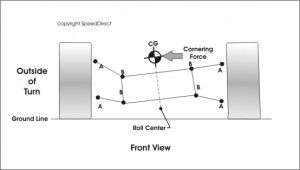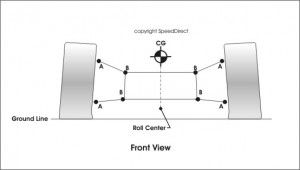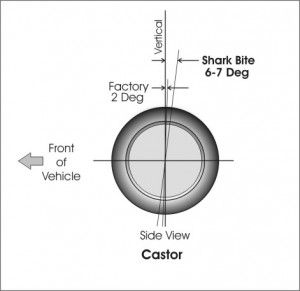Why A-arm Geometry Matters
A-Arms: What Makes The Difference?
So what’s the big deal with a-arms? Your car already has a set so why replace them? Let’s look at some very good reasons for upgrading.
Geometry:It is just like the stuff you did in high school. A suspension system obeys the rules of geometry concerning how the wheel moves when you hit a bump, or when you take a hot corner. The travel is predictable because it is controlled by where the suspension pivots, how far it can travel and most importantly the angles that start and stop its travel. These angles are established by design. The suspension engineer looks at the vehicle mass, the center of gravity, tire size and width then selects a setup that is a compromise between reasonable handling, and the ability to mass-produce the parts at a budgeted price. Let’s look at the C2 and C3 Corvette and see what Zora Duntov and the boys chose for the car.
The frame and front suspension parts are identical to the ’63-’82 Vettes. When the Sting Ray came out in ’63 wide tires were not around, and low profile tires were not available. Tires have come a long way since then and they have an effect on suspension since the contact patch, the “footprint”, of the tire on the ground is so much wider than it was back then.

When you barrel into a tight corner the car will rotate about the roll center (an imaginary point explained in another not so imaginary article we have written) that are joined or coupled, to the center of gravity (CG). When this occurs the camber causes the wheels to change their vertical orientation. This movement is called camber gain. What the Shark Bite TM arms do is to raise the roll center so it is closer to the CG; the closer the better (up to a point.) This is because there is less leverage to roll the car. The effect camber gain has is to keep the wheel more vertical in turns. The more vertical the more contact patch is in touch with the ground the more grip the car will have.
As you can see starting with a negative camber sets the car up to maximize contact patch in a turn. The opposite is true if for some strange reason you started with positive camber. With positive camber as the suspension is loaded, and the car rolls (leans) the tire would not remain flat and thereby lower available traction.
We have found that the factory design puts the front roll center below the ground line! This is not good since there is more leverage (distance from the center of gravity to roll center). The result is more body roll and insufficient camber gain to keep the wheels as vertical as possible. The Shark Bite TM aluminum alloy a-arms raise the roll center by 21%, reducing body roll and greatly improving camber gain.
Weight:
A-arms contribute to what is known as un-sprung weight or mass. It is the mass of the suspension the a-arms, spindles, springs; everything attached to it rather than what it supports like the chassis, engine, body and you. Reducing this un-sprung mass allows the suspension to follow uneven ups and downs of the road or track to keep the contact patch on the ground because there is less mass to push around. The less un-sprung mass the more responsive the suspension can be at following bumps, the more traction you will have.
Smarter is Better
The easy modification of bolting on new a-arms can greatly improve the geometry and ultimately handling of your classic Corvette. Some of the benefits of modernizing your car with this upgrade are:
-
Raising the roll center for less body lean and more traction in turns.
-
Improved re-centering with more positive castor.
-
Reducing un-sprung weight for better suspension response to bumps.
-
They look cool.

